Unit V - Plants Anatomy and Physiology
Ch 13.6 - Control of Plant Growth and Development
Plant growth regulator: a chemical produced by plant cells that regulates growth and differentiation
Plants can modify their growth and differentiation through plant growth regulator
- act by signaling plant cells to undergo particular changes
- auxins, gibberellins, cytokinin, ethylene, and abscisic acid
- can be categorized in tropism and nastic movement
Tropisms and Plant Growth Regulators
Tropism
Tropism: a directional change in growth/ movement in response to a stimulus and occurs slowly / not noticeable
\
Phototropism: a change in direction of a growing plant in response to light\
Gravitropism: a directional change in growth pattern in response to gravity\
Thigmotropism: a directional change in growth pattern in response to touch
Tropism is a change in the direction of growth/movements of a plant in response to a stimulus
- controlled by plant growth regulators
Phototropism: a change in direction of growth of a plant in response to light
- plant can bend towards areas of higher light in an attempt to maximize the amount of light they received
- positive phototropism: towards the light
- negative phototropism: away from the light
Gravitropism: a change in the direction of growth in response to gravity
- regardless of the orientation of the plant, the root will always grow downwards - positive gravitropism
- regardless of the orientation of the plant, the stem will always grow upwards - negative gravitropism
- also known as “ geotropism”
Thigmotropism: a change in the direction of growth in response to contact
- slow responses to touch/pressure
- eg. vines have positive thigmotropism
Chemotropism: a change in the direction of growth in response to chemicals
- eg. root grow towards useful minerals but away from acids
Hydrotropism: a change in the direction of growth in response to water
- eg. root exhibit positive hydrotropism
Nastic movements
Turgor response/nastic movements: quick responses to stimuli
- does not depend on the direction of the stimulus
- movement is reversible
- turgid cells filled with water quickly lose water and pressure
- eg. venus fly traps, Mimosa plants
Hormones
Hormone: a chemical that affects how organism functions, causing the organisms to respond in various ways to the chemical signal
The growth and development of many plants and development of plants are regulated by the activity of plant hormones
- auxin, cytokinin, gibberellins, abscisic acid, ethylene
Auxin: promotes cell elongation and suppresses the growth of lateral branches and leaves drop in spring
- shoot apical meristem is the main site of auxin synthesis
- diffuse down from the shoot tip to cells on its shaded side → stimulate cells elongation by loosening up cellulose → causing the shoot to bend towards the light
- stimulate cell division in the vascular cambium and promotes the formation of new lateral meristems and new root apical meristems
- eg.1 - synthetic auxins may also be applied to fruits to induce cell elongation
- eg.2 - spraying auxins on orchard can artificially synchronize the ripening in all plants → reduce the cost of harvesting the fruits as most of the fruits can be picked at one time
Apical Dominance: the condition in which most shoot growth from apical bud and not lateral buds
Apical dominance is an example of auxin inhibiting cell division
- cell division occurs in the apical bud but is inhibited in the lateral buds
- caused by the high level of auxin released in the apical meristem
- grower can cause a plant to produce more flowers, fruits/leaves by removing the apical bud
- eg.1 - basil plants can be made bushier by removing the apical bud
Gibberellins: promotes cell division and cell elongation
- produced by the young tissues of shoots and by developing seed, but from leaves and young roots as well
- help make the stored carbohydrate reserve available to the growing embryo
- eg.1 - grapes are sometimes sprayed with gibberellins to induce fruit production → cause fruit stem to elongate → give each grape more space to grow → grape grows larger → make the grape bunch look larger and more appealing
Cytokinins: promote cell division and differentiation through mitosis
- found in tissues that are actively diving, such as meristems, young leaves, and growing seeds
- stimulate adventitious buds
- slow cell aging by inhibiting protein breakdown and stimulating protein synthesis
- eg.1 - synthetic cytokinins are sprayed on lettuce and mushrooms to keep them from spoiling
Ethylene: “plant stress hormone” as it induces changes that protect a plant against environmental stress
Senescence: developmental events in a plant tissue/organ from maturity to death
- regulates the growth of roots and shoots around obstacles → causes the roots to grow sideways → no longer produced when root cells no longer touch the stone
- stimulate fruit ripening, shoot and root growth and differentiation, and flower opening
- stimulate fruit drop and flower and leaf senescence, losing leaves in drought conditions
- release ethylene as fruits ripen, which induces further ripening and eventually spoilage
- eg.1 - an increase in ozone leads to the increase of ethylene production in plants → reduces crop yield
- eg.2 - producers ship fruits in well-ventilated trucks that contain ethylene-absorbing filters or shipped separately to make sure all products all ripen at the same time → helps the product sell more steadily
Abscisic Acid: respond to changes in temperatures and light, maintains dormancy in leaf buds and seeds
- reason why deciduous trees are dormant over winter and grass, becomes dormant and turns brown during hot, dry periods as dormant plants are less vulnerable to damage
- control the closing of stomata → Abscisic Acid diffuses to the guard cells of the stomata and induces them to close → leaves can conserve their internal water
- eg.1 - Abscisic Acid is applied to plants before they are shipped from nurseries to garden centers so they can be less vulnerable to damage
Ch 12.5 - Transport in Vascular Plants
Phloem: transport of sugars
Xylem: transport of water and nutrients
Basic Overview of transportation:
Water and dissolved nutrients from soil enter plant roots by passive active transport through the plasma membrane of root hairs → Water and dissolved nutrients travel from root hairs into xylem vessels by passing through/between cells → Vascular tissue distributes substances throughout the plant, sometimes over great distances → Cells load and unload sugars into and out of the phloem
Transport in the Roots
Water enters the root by osmosis, but nutrients enter by active transport
\
Osmosis: the diffusion of water molecules across a selectively permeable membrane, from an area of high concentration to an area of lower concentration\
The key role of the Casparian strip is to prevent substances from leaking back into the cortex
The cytoplasm of plant cells has a lower concentration of water molecules than soil water, and the cell membrane allows water molecules to cross freely → water molecules enter cells in the plant roots by osmosis → water flows through the epidermal cells, cortex → water molecules move towards the vascular cylinder
The concentration of nutrients in the cytoplasm of a plant cell is higher than the concentration of nutrients in the soil water → must use active transport to move nutrients from the soil to roots cells → moved through the cells of the cortex towards the endodermis
- movement is made easier since the adjacent plant cells have interconnecting stands of cytoplasm
→ once nutrients/water enter a root cell, they would not need to cross another cell membrane until they reach the vascular cylinder
Water molecules and nutrients reach the endodermis → pass directly through the endodermal cell → nutrients are actively pumped across cell membranes into the xylem once they’re inside the vascular cylinder
Transport into the Stem
Root pressure: the osmotic force pushing xylem sap upwards in root vascular tissue
\
Capillary action: the tendency of a liquid to rise/fall because of attractive forces between the liquid molecules
Water molecules and dissolved nutrients cross the Casparian strip → form xylem sap → create root pressure and help push the xylem sap upwards as concentration increases and water molecules follow by osmosis
Capillary action: the tendency of a liquid in a narrow tube to rise and fall
- Adhesion - a column of liquid is held together by weak attractive forces between molecules and rises because of attractive forces between the liquid and the side of the tube
Cohesive-tension: Attractive forces occur between water molecules and molecules in the cell walls
- water molecule in xylem sap stick to each other and are drawn up from the sides of the xylem tubes → water column moves upward → xylem sap move from one xylem tube to another through pits in the cell wall/move out of the xylem through pits into the surrounding tissue
→ ensure all cells in the plant body receive water and nutrients
Transport to the leaves
Transpiration: evaporation of water through the stomata of plant leaves
\
The main driving force of transport up the xylem is Cohesion-tension (transpiration)\
Turgor: pressure caused by the fluid contents of central vacuole, which pushes against the wall of a plant cell
Plants release water vapor through stomata during transpiration → water evaporates through the stomata when they are open → water molecule moves up the xylem column → pulls neighboring water molecules with them and etc.
- due to the attractive force between water molecules, one is able to pull another up
- Water and dissolved nutrients enter the root by osmosis and active transport → 2) Release of water molecules through transpiration in the leaves drives the uptake of replacement water molecules from soil → 3) Transpiration continues to pull the column of water up the xylem tubes w/ root pressure and capillary action → 4) Transpiration pulls the column of water up through the xylem tubes and evaporates
A plant cell stores water and dissolved substances in its central vacuole → exerts pressure against the cell wall when it’s full → Turgor
- help support the plant
- water moves out of the vacuole when the plant is unable to take up water from soil → plant wilt
Transport of Sugar
Source: plant cell with a high concentration of sugars and other solutes
\
Sink: plant cells with a low concentration of sugar → may be converted to starch for storage/used for energy/building blocks for carbohydrates\
Angiosperm - companion cells transport sugar from source cells to the sieve tube elements\
Gymnosperm - sugars are transported from source cells directly into sieve cells
Sugar can move bi-directional
- depends on the location of source cells relatives to sink cells
- generally, sugars are transported from a source to a sink, which is connected by columns of phloem cells
Eg.1 - the location of sink and source cells in plants often changes in seasons
- winter: many plants are dormant → do not grow or photosynthesize
- spring: plants depend on carbohydrates stored in roots and stems → plant breaks down starch as sugar
- spring: root and stem cells are sources, and sink is mainly the leaves → phloem moves up
- summer: leaves produce sugar → sources, and the roots and stem cells are the sinks → phloem moves down
The produced sugar transport to the phloem involves active transport → concentration of sugar in the phloem sap increase → water are drawn from the xylem cells into the phloem cells by osmosis → increase the turgor of phloem cells
concentration of sugars in phloem cells is generally higher than the concentration in the source cell
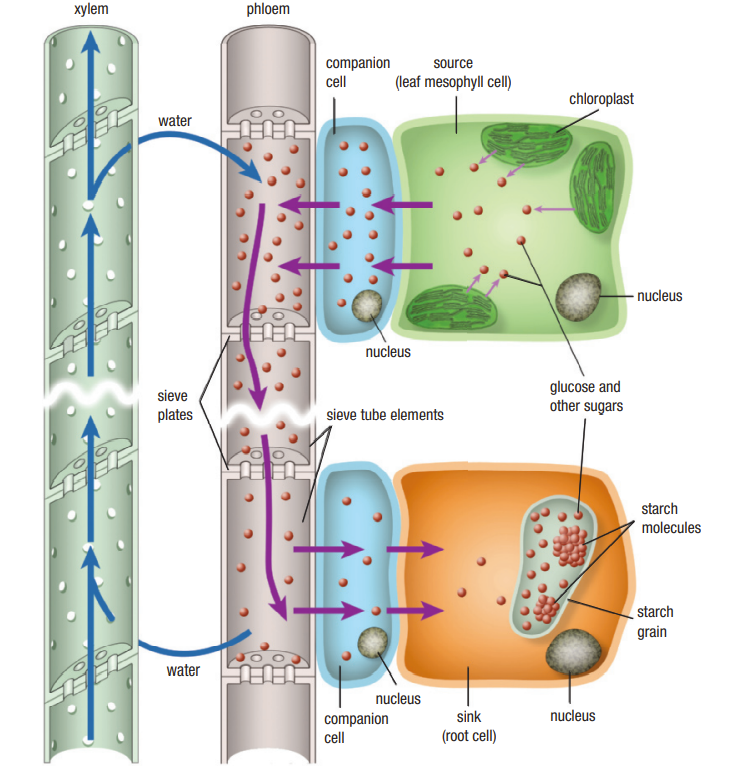
Translocation
Translocation: long-distance transport of substances through the phloem, particularly glucose
Phloem tubes are not hollow, substances in the phloem sap have to move between living cells
It is suggested that translocation is driven by the difference in turgor between the phloem cells near source cells and the turgor of phloem cells near sink cells
- differences in turgor push the phloem sap towards the direction of sink cells
Sugar molecules leave the phloem once they reach a sink cell → sugar moves from the phloem to the sink by passive transport → sieve tube elements have a lower concentration of sugar → water returns to the xylem from the phloem
- maintains the relatively low turgor of phloem cells near the sink
- recirculates the water back into the xylem
Ch 12.4 - Roots
The main role of plant roots: is to anchor the plant and keep it upright, to absorb water and nutrients other than carbohydrates
→ some roots store water and carbohydrates for the plant
Types of Root Systems
Taproot system: a root system composed of a large, thick, root; can have smaller lateral roots → Eudicot
\
Fibrous root system: a root system made up of many small, branching roots → Monocot\
Lateral root: a smaller root that branches from a larger root\
Root hair: a microscopic extension of the epidermal cells of the root
General Structure of Roots
Root cap: the mass of cells that form a productive covering for the meristem at the root tip
\
Root cortex: a region of parenchyma cells under the epidermis of a root\
Endodermis: the innermost layer of cells in the cortex of the root\
Casparian strip: the wax-like strip that runs through the cell wall of an endodermis cell\
Vascular Cylinder: the central portion of a root that contains the xylem and the phloem
The tip of the root contains the root cap and a meristem. and behind the apical meristem is the region of elongation followed by the region of maturity
- root cap produces a slippery substance that helps the root to penetrate the soil → minimize the damage to the root cells
- meristem produces new cells to increase the length of the root
The Root hairs are found above the root tip, projecting outward from the epidermis
- increase the surface area of the epidermis → the root can absorb water and dissolve nutrients more efficiently
The root cortex is a region of parenchyma cells beneath the epidermis
- store carbohydrates and help transport water from the epidermis to the xylem
- ends at the endodermis → walls are wrapped with a wax-like substance which forms the Caparian strip
The vascular tissues of roots are contained in the vascular cylinder
gymnosperms and eudicot - in the center of the root, forming an X/star shape
Monocot - the center of the root contains parenchyma cells, surrounded by a ring of xylem and a ring of phloem cells
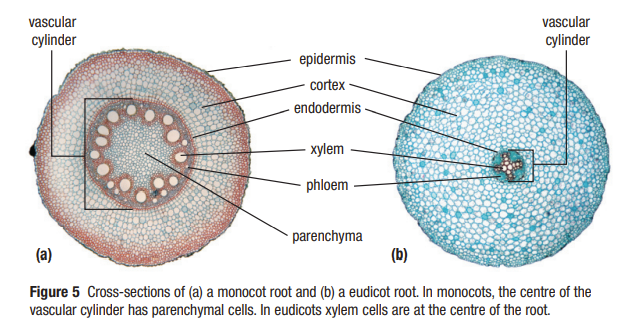
Root specialization
Tuberous Root: a lateral root specialized in storing carbohydrates
\
Adventitious Root: a root that develops from somewhere other than the root apical meristem that emerges from the seed
Root specialization may help roots to
- more efficiently absorb water and nutrients
- anchor the plant
- store carbohydrates
- help protect the roots from being eaten
Almost all plants have relationships with other organisms
- The roots of over 80% of plants have a mutualistic relationship with Mycorrhizal - the fungi can get into smaller spaces and are able to release digestive enzymes that break down organic matter → receive carbohydrate
- some root species and nitrogen-fixing bacteria - the bacteria take nitrogen from the air and convert it into a form that plants can use → receive carbohydrates and live within the nodules
- strangler fig and other organisms - the fig will obtain water and nutrients from the host tree and the roots will prevent the host’s trunk from growing outwards → host tree dies and loses its leaves, and leave behind a large hollow space within the strangler fig → strangler fig engulf the trunk of the host and becomes the host
- humans and plants - most roots eaten by organisms are specialized for carbohydrates storage (eg. carrots and beets → taproot, Yams, cassava and sweet potatoes → tuberous roots)
Some roots produce chemicals to avoid the risk of being eaten by other organisms
- eg.1 - bitter roots - the bear root taste so horrible that few animals would eat them
- eg.2 - Cassava roots produce a deadly toxin to protect them
- eg.3 - black walnut root secretes a toxin that inhibits the growth of other plants
- eg.4 - common reed releases a corrosive acid that breaks down the roots of the neighboring plants
Human Uses of Roots
We use roots for food, for ourselves and our livestock
- food - parsnip, turnips, beets, taro, and sweet potato
- Ourselves - licorice roots can be used in candies, roots can be used for beverages
- livestock - Cassava, turnips, yams, rutabaga, and other roots
- chemicals - can be used to dye textiles (eg. beet/madder for red, and dandelion for brown), pesticides (eg. Rotenone)
- Medicine - Ipecac (induce vomiting and prevent further absorption of poison), Kava kava (eg. reduce anxiety)
Erosion Control
Roots are useful in controlling erosion
- fibrous roots can form a mat that holds the upper soil layers in place during heavy rain, snow/wind
- trees can be planted to control erosion → often done after an area of the forest has been clear-cut since it exposes the soil surface which makes it vulnerable to erosion
Ch 12.3 - Stems
Roots connect the vascular tissue in the leaves to the vascular tissue in the root → allowing water and dissolved substances to be transported throughout the plant body
\
Roots also raise and support the leaves and reproductive organs→ maximize their exposure to sunlight so they are able to photosynthesize more efficiently
→ place the organs in an ideal position to photosynthesize more effectively
\
Some can store water/carbohydrates, and to protect the plant from injuries and herbivores
Stem Structure
Herbaceous: describes plants with stems that do not have wood
\
Woody: describes plants with stems that contain wood
Herbaceous plants’ stems are relatively pliable, carry out photosynthesis and have a thin epidermis
Woody plants’ stems are relatively hard, have bark, and do not usually carry out photosynthesis
- all gymnosperms/eudicots have woody stems
Anatomy of Herbaceous Stems
Vascular Bundle: arrangement of vascular tissue that consists of xylem and phloem
Vascular bundles run continuously from the roots to the leaves
xylem is always close to the center while phloem is always closer to the outside of the stem
vascular bundles are scattered throughout the parenchyma - monocot
vascular bundles are arranged in a ring around the margin of the stem and occupied by pith - dicot
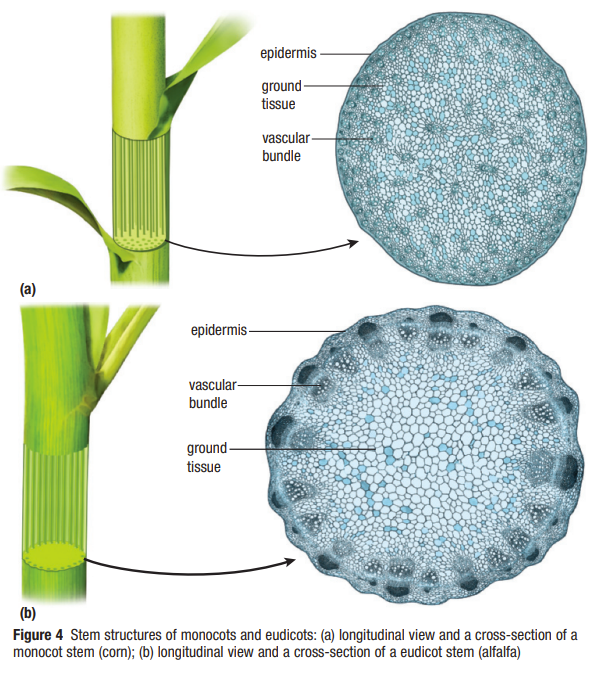
Anatomy of Woody stems
Vascular Cambium: the meristematic cell layer in vascular tissue
\
Bark: the protective outermost layer of the stems and roots of woody plants; consists of phloem, cork cambium and cork\
Cork cambium: the meristematic layer in a woody plant that produces cork
Vascular cambium is a layer of meristematic cells in the vascular tissues that divide to form new xylem and phloem cells
- secondary xylem grows to the inside of the vascular cambium, and secondary phloem to the outside → increase the width of the plant
Sapwood is the younger xylem through which water and minerals are transported to the leaves → older xylem layers fills up with resins and oils and no longer conduct water → form heartwood
- heartwood helps support the tree
Bark consist of phloem, cork cambium, and cork
- phloem transport sugars made in leaves throughout the plant
- protect plants from herbivores and low-temperature fires (eg. Ontario’s red and white pine)
Cork cambium is a layer of meristematic tissue that produce cork
- cork prevents water loss from the stem
The apical meristem is embedded in the tip of the stem within the Terminal bud
Along the side of the stem are lateral buds that forms new branches and twigs → leaves unfold at intervals as terminal bud moves up
leaves attached at points - nodes
spaces between nodes - internodes
openings - lenticels → permit gas exchange between stem and surrounding air
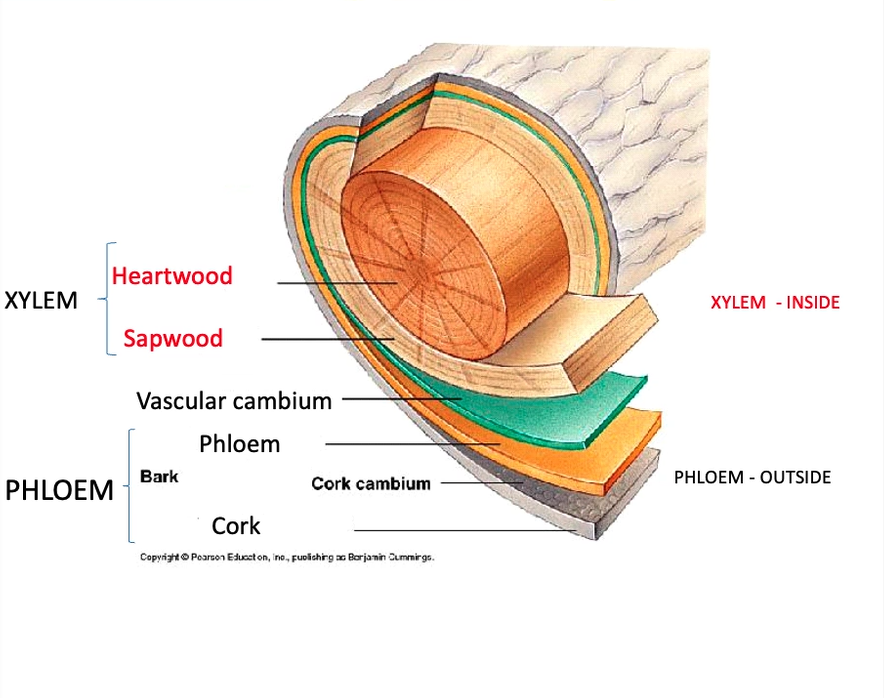
Spring wood - the vascular cambium grows rapidly in spring, producing large xylem cells that have thin walls → wood is less dense and in light color
Summer wood - fewer xylem cells are produced and have thicker cell wall → wood is more dense and in dark color
Cell Types in Vascular Tissues
Xylem: thick walled and dead at maturity, cell walls are rich in lignin
\
Phloem: contain cytoplasm, living at maturity\
Tracheid: elongated, tapered xylem with thick cell walls containing small pits, that overlap one another to form continuous tubes from root to shoot\
Vessel element: a shorter blunt-ended xylem cell with thick cell walls containing small pits, stack end to end to form vessel tubes that run from root to shoot\
Perforation plate: perforated end wall of a vessel element\
Sieve cell: phloem cell with pores in its cell walls, contains all necessary cell organelles\
Sieve tube element: a phloem cell with pores in its side cell walls, lack organelles and depend on associated companion cell\
Sieve plate: the perforated end wall of a sieve tube element\
Companion cell: a small nucleated phloem cell that is always associated with a sieve tube element\
Xylem
Tracheid all have pits → allow water and solutes to pass up or across to neighboring xylem cells
Vessel element is shorter and wider and have less tapered end
Perforation plates are end walls with one/more openings → allow water and solutes to pass through
→ gymnosperm: tracheid
→ angiosperm: tracheid and vessel elements
Phloem
Sieve cells have narrow pores, organelles including a nucleus
Sieve tube element have cytoplasm but lack cell organelles
Sieve plates are perforated → allow sugars solution to pass to neighboring phloem cell
Companion cell have a nucleus and organelles
→ gymnosperm: sieve cells
→ angiosperm: sieve tube element and companion cell
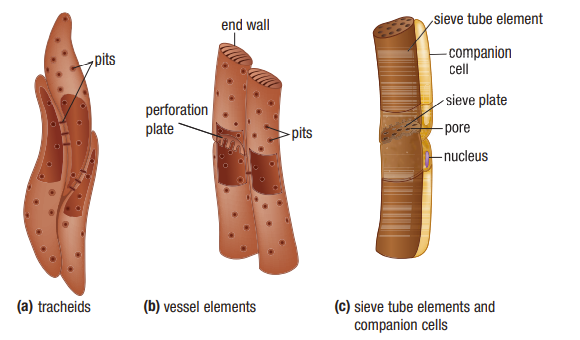
Stem Specialization
- stolons are modified stems that grow along the soil instead of upright
- spider plants produce new plants on the ends of stolons
- vines take advantage of other objects to raise and support their leaves
Human Uses of Stems
Fuel
- ethanol
- wood
Food
- sugar canes
- potato
- yams
- maple syrup
- asparagus
Textiles
- flax - manufacture linen
- hemp - produce textiles
- bamboo - make clothing w/ other natural fibers such as cotton
Dyes
- indigo - dye jeans
- hematoxylin - stain used to prepare microscope slides
Chemicals
- tannin - wood stains
- turpentine - solvent
- latex rubber - gloves, tubing and erases
Medicine
- salicylic acid - pain reliever made from willow bark
- taxol - anti-cancer drug from bark and needles of yew trees
Ch 12.2 Leaves
Functions of Leaves
Chloroplast: organelle found in large numbers in many plant cells, site of photosynthesis within a plant cell
\
Photopigment: a pigment that undergoes a physical/chemical change in presence of light\
Leaves are the primary site of photosynthesis\
The plant used glucose as a building material and as an energy source for cellular processes
Leaf absorb energy from sunlight in a chloroplast → which contains various photopigments
- photopigments are chemicals that absorb particular wavelengths in the light
- chloroplasts also
- eg.1 - chlorophyll absorbs light at the red and blue ends of visible lights → gives leaves their green color
Leaves carry out the gas exchange between the interior of the plant and its environment
- epidermis contains many pores → allow for gas to pass in and out
- photosynthesis (use CO2 and release O2) and cellular respiration (use O2 and produce CO2) requires gas exchange
Leaves may offer protection from herbivores
- protect themselves with surface hair w/ irritating compounds → make leaves unpalatable
- produce toxins or bad-tasting chemicals → deter herbivores
- eg.1 - leaves in cacti are reduced to sharp spines → protect photosynthetic stem
Structures of Leaves
Blade: the flat part of a leaf
\
Petiole: stalk that attached the leaf blade to the plant stem
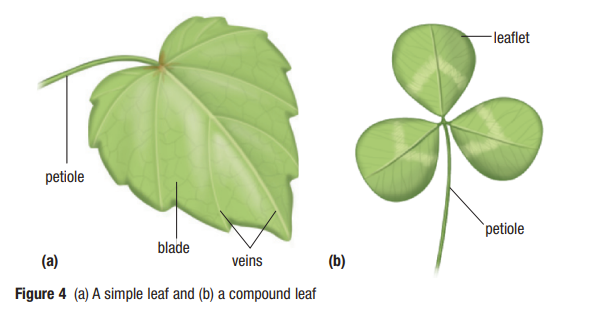
Venation: the arrangement of veins within a leaf
Monocots
- have parallel venations
- have narrow leaves
Dicot
- have branching venation
- have broad leaves
Internal Structures of Leaf
Mesophyll: the photosynthetic middle layer of cells in the lead of a terrestrial plant
\
Palisade mesophyll: the later of elongated photosynthetic cells arranged in columns under the upper surface of a leaf on a terrestrial plant, part of mesophyll\
Spongy mesophyll: the latter of loosely packed photosynthetic cells with large air spaces between them under the lower surface of a leaf on a terrestrial plant, part of the mesophyll\
Stoma: opening in leaves through which gases pass in and out of leaves\
Guard cells: one of two kidney-shaped cells that control the opening and closing of a stoma
The epidermal cells are tightly packed in a single layer and covered by a waxy coating called the cuticle
- cuticle prevents water loss → provides a physical barrier against bacteria, molds, and insects
- transparent → so light can pass through to the cells within → does not carry out photosynthesis
Mesophyll
- Palisade mesophyll are elongated and closely packed, and contain many chloroplasts → maximizing amount of light collected and use for photosynthesis
- Spongy mesophyll are loosely packed and have large air spaces → allowing for gas exchange between the mesophyll cells and the atmosphere through stomata
Stomata
- an opening in the epidermis, through which gases pass in and out
- regulates the rate of gas exchange
Guard cells
- are thicker on their inner side → when swollen with water, they bow outwards → open stomata
- turgor pressure - the pressure exerted on the guard cell to open
- low concentration of CO2 and an accumulation of potassium ion + environmental conditions (i.e. temperature) → instigate the opening
Aerenchyma
- tissue composed of loosely packed parenchyma with large pores
- help leaves float on the surface of the water for aquatic plants
Leaf Specialization
Leaves have a specialization that protects the plants
produce chemicals in their leaves to repel herbivores
→ eg.1 - tobacco plants produce nicotine
deters herbivores from structural specialization
→ eg.2 - cacti have spines that protect the stem from being eaten
plants will lose their leaves in fall → help conserve water and nutrients during winter
Gymnosperm have small leaves, a thick epidermis, and cuticle, and stomata are recessed below the epidermis, and chemicals that prevent them from freezing → prevent water loss
→ conifers (i.e. spruce and pines) have needle-shaped leaves → allow shedding snow more readily
Human Uses of Leaves
Dark green leafy vegetable (spinach)
- contain calcium, potassium, iron, magnesium, vitamins B, C, E, and K,
- provide nutrients that protect our cells from damage such as beta-carotene, lutein, and zeaxanthin
- contain a small amount of omega-3 essential for brain and heart function
Cuticles
- wax produced by carnauba palm leaves is used to make car and furniture polishes, surfboard wax, coating for candies, and ingredient in chocolate
- Candelilla produced by Euphorbia Cerifera is used to make lipstick
Leaves
- leaves of sweet grass plants are used in NA Aboriginal people’s religious ceremony
- braided sweet grass is burnt at the start of ceremonies to purify spirits by the Cree and Anishinaabe Algonquian people
- palm leaves are used to make thatched roofs
Leaves and Chemicals
Many species protect themselves by synthesizing toxic chemicals in their leaves
- eg.1 - hydrangea leaves can cause vomiting, diarrhea, or even coma
- eg.2 - leaf blades of rhubarb plant can cause vomiting, nausea, or even kidney damage
Some plant poisons can be beneficial in cancer treatments → used to kill the rapidly dividing cancer cells
- eg. 1 - vincristine → treat childhood leukemia and vinblastine → treat Hodgkin’s disease produced by rosy periwinkle
Psychotropic drugs
Psychotropic drugs: mind-altering
some plants produce chemicals that alter perception, emotion/behavior
- eg.1 - marijuana produce psychotropic compound tetrahydrocannabinol → increases appetite and reduces nausea and may reduce muscle spasms, reduce internal pressure in the eye → useful in treating glaucoma
- eg.2 - coco plants produced cocaine→ that suppresses hunger, pain, and fatigue. and help lessen the symptoms of altitude sickness; produce euphoria, talkativeness, and alertness, and produce paranoia, irritability, and nervousness
Ch 12.1 - The characteristics of plants
Basic Needs of Plants
Carbohydrate: a molecule that contains only atoms of carbon, hydrogen, and oxygen in a ratio of 1:2:1
Plant capture energy from incoming solar radiation and convert it to chemical energy through photosynthesis
- carbon dioxide + water → glucose + oxygen
Carbohydrate is a molecule that consists of carbon, hydrogen, and oxygen atom
- main source of chemical energy needed for maintenance, growth, and development
Plants have developed different adaptations to capture as much light as possible
- eg. adjusting the position of their leaves to maximize their exposure to light
Plants also developed ways to protect themselves
- produce toxic/bad-tasting substances
- produce a tough, hairy/prickly later
Plants need specific nutrients (i.e. Nitrogen, Phosphorus, and Potassium) in order to synthesize proteins, lipids, and other compounds
- plants absorb nutrients as dissolved substances in water with the help of mycorrhizal fungi
The Vascular Plant Body: Roots and Shoots
Meristematic tissue: issue consisting of dividing undifferentiated cells found in areas of the plant where growth can take place
Dermal Tissue
- epidermis and periderm
- outermost cell layers
- often have thicker cell walls
- covered by a waxy cuticle
→ protect against injury, herbivores, diseases, and water loss
Vascular Tissue
- xylem and phloem
- xylem - thick-walled cells, dead, and maturity
- phloem - thin-walled cells, living at maturity
→ transport water and nutrients and support the plant body
Ground Tissue
- Parenchyma - thin-walled cells, living at maturity
→ perform cellular processes to support growth and development
→ store carbohydrates, especially starch
- Collenchyma - thick-walled cells, living at maturity
→ perform cellular processes to support growth and development
→ support and protect plant body
- Sclerenchyma - cells with lignin in their cell walls, dead at maturity
→ support and protect plant body
Meristematic Tissue
- the undifferentiated cell → become vascular, ground, or dermal tissue
- primary growth of plant occurs in the apical meristem
- second growth occurs in lateral meristem tissues
Updating the Phylogeny of Vascular Plants
Kingdom: Plantae
Subkingdom: Bryophyte, Tracheophytes
→ division: seed producing, Spore producing
Class: Gymnosperm, Angiosperm, Lycophytes and Pteridophyte
Order: Monocotyledon, Eudicotyledon
Basic Overview of Monocot vs Dicot
Seed leaves
- monocot: one cotyledon
- dicot: two cotyledon
Vascular Bundle
- monocot: scattered throughout the stem
- dicot: forms a ring around the stem
Flowering parts
- monocot: multiples of 3
- dicot: multiples of 4/5
Leaf Venation
- monocot: parallel veins and narrow leaves
- Dicot: branching veins and broad leaves
Roots
- monocot: fibrous roots
- dicot: taproot